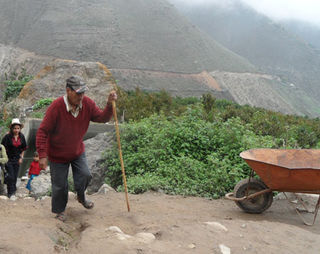Despite Blindness, the Peaches are Sweet in Paran
Eye On the Cure Research News
The story of vision loss in a Peruvian village

Ignacio, who’s affected by retinitis pigmentosa, walks to his peach orchard in Peru.
Paran, a village of 300 people tucked in the foothills of the Andes near Lima, Peru, is known for its sweet peaches, but also its high rate of blindness. About one in eight Paranos have lost their vision. Until recently, the villagers never understood the cause of the affliction, though they suspected there might be a genetic component because it runs in families. However, most had never even received care from a doctor.
But a visit from Ricardo Fujita, Ph.D., a genetic scientist at the University of San Martin de Porres in Lima, helped shed light on Paran's blindness. He was dispatched to Paran by doctors who had been part of a medical outreach effort initiated by a mining company.
"Dr. Marco Valverde learned of my previous work with retinitis pigmentosa at the University of Michigan, where I worked with Dr. Anand Swaroop in the late 1990s. He invited me to visit Paran in a campaign with the ophthalmologists," explained Dr. Fujita, who returned to Peru after his postdoctoral studies at Michigan.
Because of the early symptoms, which include night blindness and loss of peripheral vision, the ophthalmology team suspected retinitis pigmentosa (RP) was the culprit. The fact that mostly males were affected led Dr. Fujita to believe it was the X-linked form, in which women are carriers of the condition but usually don't suffer vision loss. His genetic study confirmed X-linked RP (XLRP) caused by a mutation in the RPGR gene.
The good news is that the Foundation Fighting Blindness is funding development of an XLRP gene therapy.
Gus Aguirre, V.M.D., Ph.D., and William Beltran, V.M.D., Ph.D., at the University of Pennsylvania, are conducting pre-clinical studies in preparation for a human trial of an XLRP gene therapy to be launched by Applied Genetic Technologies Corporation.
However, getting the villagers access to the emerging treatment could be challenging. Paran, located in rugged highlands, is a four-hour car trip from Lima. Also, some of the town's leaders are reluctant to get involved in medical research.
Dr. Fujita says that prevalent blindness and the diagnosis of XLRP have led to some unwarranted negative publicity for Paran's peach business.
"For most of them, blindness is not an impediment to working in their peach orchards. They know the orchards by heart, some of which are kilometers away from their homes across rocky terrain," he explains. "Peaches are their lives. They aren't asking for anything more."
Yet, Dr. Fujita believes that eradicating the town's blindness would have a beneficial impact. "It would be great," he says, "to find a cure for the people of Paran."




